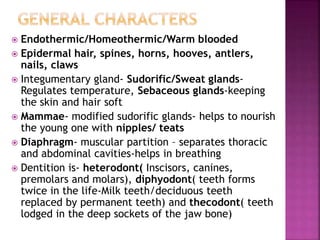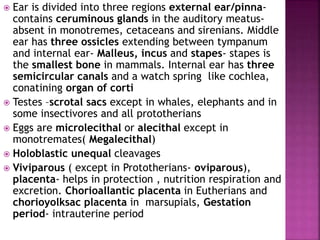Mammalia.pptx
- 1. ASHOK KUMAR BOLLAPALLI LECTURER IN ZOOLOGY KRK GOVT. DEGREE COLLEGE ADDANKI-523201
- 2. ï Endothermic terrestrial Vertebrates that dominated during Cenozoic era ï Originated from theropsid reptiles in Triassic period ï Occupy the top of evolutionary ladder due to their superiorly organized brain ï Largest mammal- Balanoptera musculus- 35 meters long and 120 tones weight ï Largest land dwelling mammal- African Elephant- Elephus maximus ï Longest Mammal-Giraffe-16 feet- Giraffa camelopardalis ï Smallest mammal- Etruscan Pygmy Shrew ï Bumble bee bat
- 3. ï Endothermic/Homeothermic/Warm blooded ï Epidermal hair, spines, horns, hooves, antlers, nails, claws ï Integumentary gland- Sudorific/Sweat glands- Regulates temperature, Sebaceous glands-keeping the skin and hair soft ï Mammae- modified sudorific glands- helps to nourish the young one with nipples/ teats ï Diaphragm- muscular partition â separates thoracic and abdominal cavities-helps in breathing ï Dentition is- heterodont( Inscisors, canines, premolars and molars), diphyodont( teeth forms twice in the life-Milk teeth/deciduous teeth replaced by permanent teeth) and thecodont( teeth lodged in the deep sockets of the jaw bone)
- 4. ï Salivary glands in the buccal cavity are four pairs-parotid, Sub maxillary/Sub mandibular, Sub lingual and infra orbitals(absent in Man) ï Skull is dicondylic, Each half of the jaw bone is composed of a single bone, the dentary, articulating with the sqamosal of the skull, A bony secondary palate formed by the union of premaxillae, maxillae and palatine bones, separates nasal and oral passages. Vertebrae are with flat centrum(Acoelous/ Amphiplatyan). Ribs double headed, Cervical vertebrae are seven except in three toed sloth(9), two toed sloth(6) and manatee(6) ï Respiration is by lungs, glottis is guarded by a flap called epiglottis
- 5. ï RBC are enucleated, boconcave and circular except in Camels and Llamas where they are elliptical. SAN pacemaker, AVN- Ectopic pacemaker-behaves as pacemaker when SAN fails, Heart four chambered, double circulation, two aortic arches, Renal portal system is absent ï Kidneys are Metanephric. Excretes urea- ureotelic ï Cerebral hemispheres-large and exhibit convolutions. Carpus callosum- transverse band that connects cerebral hemispheres. Corpora quadrigemina- optic lobes four. Cerebellum is large, cranial nerves are 12 pairs ï Eyes are with lacrimal, harderian and meibomian glands whose secretions moisten and lubricate the conjunctival surface of the eye ball and its lids.
- 6. ï Ear is divided into three regions external ear/pinna- contains ceruminous glands in the auditory meatus- absent in monotremes, cetaceans and sirenians. Middle ear has three ossicles extending between tympanum and internal ear- Malleus, incus and stapes- stapes is the smallest bone in mammals. Internal ear has three semicircular canals and a watch spring like cochlea, conatining organ of corti ï Testes âscrotal sacs except in whales, elephants and in some insectivores and all prototherians ï Eggs are microlecithal or alecithal except in monotremates( Megalecithal) ï Holoblastic unequal cleavages ï Viviparous ( except in Prototherians- oviparous), placenta- helps in protection , nutrition respiration and excretion. Chorioallantic placenta in Eutherians and chorioyolksac placenta in marsupials, Gestation period- intrauterine period
- 7. ï It is classified into two sub classes ï Prototheria ï Theria ï Theria is subdivided into ï Metatheria and ï Eutheria
- 8. ï Reptile like, oviparous egg laying mammals with a variable temperature between 25-28 degrees Celsius ï Found in Australia, Tasmania, New Guinea ï No pinna on the ear ï in the skull tympanic bulla and lacrimals are absent; the jugal is reduced/ absent ï Teeth are present only in young ones adults are edentate and are with horny beak ï The pectoral girdle possesses large coracoid bones and T- shaped interclavicle. ï The pelvic girdle possesses epipubic bones, vertebrae without terminal epiphyses
- 9. ï The ribs are single headed ï Cloaca into which ureters and urinogenital sinus open ï Mammary glands are without nipples ï No corpus callosum ï The cochlea is a simple process of the sacculus and not coiled ï Testes are abdominal ï Females are oviparous
- 10. ï Modern viviparous marsupials and placental mammals ï Ear with pinna ï Mammary glands with nipples/ teats ï Dentate. Vertebrae with terminal epiphyses ï Cloaca is absent ï Testes are in scrotal sac. Vasa deferentia and air bladder opening through a common urethra in penis ï Ureters open into the base of bladder ï Oviducts open into a vagina ï It is divided into two infraclasses ï Metatheria and Eutheria
- 11. ï Marsupium/ brood pouch ï Mammary glands bearing nipples are sebaceous ï Epipubic bones are present and attached with the pubis ï Separate coracoid and interclavicle are absent ï Corpus callosum is feebly developed or absent ï Vagina and uterus are double/Didelphic condition ï Penis is bifid ï Placenta is rudimentary yolksac type ï Young ones are born extremely immature and crawl into marsupium attached with nipples for further development ï Confined to Australian region-Land of Marsupials
- 12. ï Didelphis (oppossum) ï Dasyurus(Tiger cat) ï Coenolestes( Opossum Rat) ï Notoryctes( Marsupial mole) ï Parameles ( Bandicoot) ï Macropus(Kangaroo) ï Phascolarctos (Koala)
- 13. ï Higher viviparous placental mammals ï Marsupium is entirely absent ï Epipubic bones are absent ï Cloaca is absent ï Corpus callosum is present ï Testes are usually contained in scrotal sacs ï Vagina is single ï Young one always nourished for considerable time in the uterus by means of chorio-allontoic placenta and born in a relatively advanced state ï Echolocation-emit ultrasounds to locate their way- Bats and whales
- 14. ï Insectivora( hedgehogs Shrews mole) ï Chiroptera (Bats and flying foxes) ï Primates( Man and apes) ï Edentata(sloth, Armadillos American ant eaters(Myrmecophaga)) ï Rodentia( Rat) ï Cetacea(Whales and Dolphins) ï Carnivora(Dogs,Cats Tigers Lion and bears) ï Sirenia(Manatees=Trichechus) ï Logomorpha (Rabbit) ï Pholidota(Manis(Pangolin/Scaly ant-eater))
- 15. ï Chordate Zoology E.L.Jordan and Dr.P.S. Verma S.Chand Publications ï Telugu Academy Zoology















